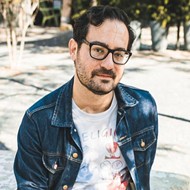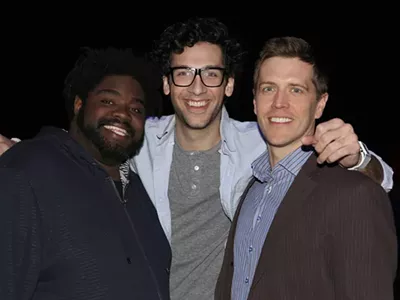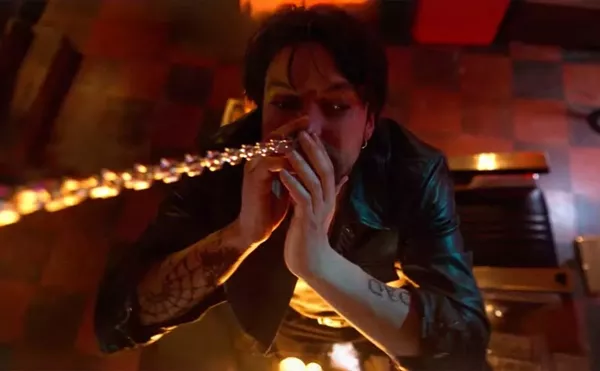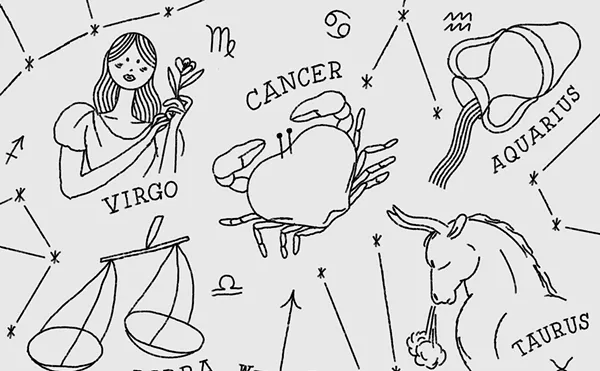Dabls walks us through his outdoor Detroit African art project
Find out why Quentin Tarantino is a fan.

Audio By Carbonatix
[
{
"name": "GPT - Leaderboard - Inline - Content",
"component": "35519556",
"insertPoint": "5th",
"startingPoint": "3",
"requiredCountToDisplay": "3",
"maxInsertions": 100,
"adList": [
{
"adPreset": "LeaderboardInline"
}
]
}
]
“When we started here, this area was just a complete dumping ground,” a man known simply as Dabls tells us (“No one knows my first name — that name is never used,” he explains. For the record, it is Olayami). These days, Dabls’ African Bead Gallery and MBAD Museum is part of a sprawling outdoor art installation near Grand River Avenue and West Grand Boulevard. The site includes impossible-to-miss buildings covered in pieces of mirrors and brightly colored paint, a sculpture garden made out of reclaimed materials, and traditional African statues. In August, it will have been 14 years since Dabls set out to create what is now arguably one of Detroit’s most iconic destinations, which draws visitors from the world over — including filmmaker Quentin Tarantino as a recent guest.
When he started his museum, Dabls was an African bead collector and salesman who spent time working at the Charles H. Wright Museum of African American History. He had been interested in African beads since 1985, when he met a trader at the Michigan State Fair. “For 45 minutes, he was talking about the significance of the beads, and I was hooked,” Dabls says. The U.S. dollar made it to Africa in the 1980s, and before that, beads were used as currency. Dabls got in at the right time — Japan began snatching up African beads as well. Some of the beads in his collection are more than 300 years old.
When Dabls got an idea to establish a museum dedicated to his more valuable beads, a woman donated the two buildings on Grand River to him in 1996 — on a handshake — for him to use. Dabls envisoned the building as a museum and a bead store. But when a collapsed roof caused delays on the museum aspect, Dabls got an idea to do something more, noting that while Detroit had Mexican, Polish, and Italian neighborhoods, there was no African town — despite Detroit being mostly African-American. Those other communities developed organically by nature of immigration, though, and African Detroiters were distanced from their native culture by nature of arriving in America through slavery. “I didn’t want to do something that was contrived,” Dabls says. “I had to be a bit more sophisticated.”
So Dabls set out creating his outdoor art installation. Titled “Iron Teaching Rocks How to Rust,” the installation is a metaphor involving the relationship of three elements — iron, rock, and wood.
“When I was working at the Museum of African American history, one of the most difficult things to talk about was the exhibit on the civil rights decade,” Dabls says. In the 1980s, when he worked at the museum, the civil rights struggle was still fresh in some people’s minds. “People have their own point of view, and it’s often not included. I was constantly being interrupted,” he says. It was only after recalling reading George Orwell’s Animal Farm in school that Dabls got the idea that social and political commentary would be easier for people to understand through metaphor.
Dabls walks us through his creation, which has a sort of logic to it that makes perfect sense as he explains it. “Rust is a state of deterioration. So if you’re rusting, that means you’ve given up something, and what that something is, is your culture identity,” Dabls says. “The whole purpose of iron making everyone learn to rust is that they wanted to mimic or assimilate themselves.”
It’s not hard to glean which cultures the different elements personify. One installation features a table set up with silverware and a large cement cake in the middle. “This is Iron teaching Rocks table manners,” Dabls says. “Rocks ate with their hands. Sociologists have discovered that if you eat with your hands out of a common bowl, your bond is much tighter. Plus when the tip of your finger touches your lip, the saliva begins to prepare the food to be digested. But when an iron object does that, the opposite occurs.” Another installation features wood, banished to a reservation with a casino made out of paint cans.
Yet another installation features filing cabinets wrapped in a thick metal cable. “Iron frees people, but it locks the history of those it freed in these filing cabinets, and surrounded them with a moat,” Dabls says.
We ask Dabls if he considers himself a historian. He prefers to use the term storyteller. “I can get away with a lot as a storyteller,” he says. “As a historian, there’s all these folks out there challenging what I say. History is told best as stories or mythologies.”
Dabls shows us one of his sculptures, a figure with nails driven into it that is meant to bring good fortune and ward off evil. “Every time you drill a piece of iron into it, you ask it to do certain things,” Dabls says. Dabls asked that the city wouldn’t take notice of his project, because he did not seek proper permits. He also asked that graffiti artists wouldn’t tag it and that vandals wouldn’t destroy it. Fourteen years in, and no one has interfered with his project.
“What I found out about graffiti artists is that they see me as a brethren, because they do stuff outside too,” Dabls says. “Ten years ago, it was a different kind of graffiti artist. They would tag anything — I’d see them tagging cars. The ones now, that whole art form has been elevated. It’s respectful now.” Dabls also credits the exhibit’s 24-hour access and free admission in lending itself to community respect. It could also be that Dabls’ garden’s meditative, non-confrontational quality offers a sort of protection as well.
When a man left a two-year stint squatting in a nearby house, Dabls was worried that it would invite destruction to his neighborhood. “When he left, he told all of his scrapping friends that the house was available to be stripped of everything of value,” Dabls says. “I realized it was a system: You take everything of value and along comes the guy who likes to see things burn.”
So Dabls boarded the house up, covering it in mirrors. Amazingly, it worked. “People are fascinated by mirrors,” Dabls says. “There’s just something about mirrors that makes us comfortable, because we can see an image of ourselves, and you can look forward and see behind you.” He first realized the power of mirrors when he used them in fine art paintings he made. “I noticed that people would go to a particular spot and look at my paintings — I was disappointed that people were just looking at themselves in my art,” he says. “So I said, ‘OK, I will forever use mirrors.’”
At this point, Dabls is a well-known figure in his community. “You cannot do anything without community approval,” he says. “I didn’t think anyone knew me. I was at the gas station a mile down the road, and the guy said, “Man, you’re the guy from that bead store down there. You have all them white people down there looking at that stuff!’”
Recent admirers include Quentin Tarantino, whose girlfriend was in town shooting a movie. “He made a generous donation, and what he said about the place was far more valuable than money,” Dabls says. “I’ve always admired this man’s work, and that he’s always had a lot of black actors. When he came here, it seemed like he and I have been friends for life.” Tarantino signed the guestbook: “Your art and your world that you’ve created is so soulful and inspiring. Thank you.”
We note that Tarantino is a controversial figure for his gratuitous use of racial epithets in his films and for Django Unchained making light of slavery. “We’re too tense with this race thing,” Dabls says. “There’s one planet here, we’ve got to create a dialogue where we can talk without being afraid about offensive things. All the other species on this planet get along except the ones that communicate with each other.”
We ask what Dabls thinks about what could perhaps be the dirtiest words of 2014: cultural appropriation. “Cultures have always been fluid. Cultures have always taken from each other. Cultures have always moved forward. They do not stagnate,” he says. “They take from what’s available. People think of African culture being pure, but China produced the silks that were used in traditional textiles. Someone out there screwed up the idea of ‘culture’ as what we do. Culture is defined as a language and a creation myth. All this other stuff we out here doing, that isn’t culture. It’s just what we do to get from point A to point B.
“A lot of things that we define as culture are just there for confusion. You have to ask, who does it benefit? The official statement of this country is that race does not exist,” Dabls says. “Yet it has the institution for observing racism. It has an institution for punishing racism. It’s sending mixed messages.”
Even though culture is up for grabs, Dabls believes it’s important to preserve and honor culture. “If [your culture] doesn’t fit in, then something’s wrong,” he says, noting the interest in his museum where there was none before. “My argument has proven itself to be true.”
Speaking with Dabls at a length, one gets a sense of a certain savvy. He mentions the basic methods of advertising more than once. He understands the value of documentation thanks to his experience working in a museum. He has a resident photographer on hand. And, perhaps unintentionally, his creation can be seen from the expressway — serving as a billboard for itself. You could even say that Dabls has spent the past 15 years successfully developing a brand. Dabls shrugs it all off, though. “It’s just common sense,” he says. “You can’t get common sense when seven or eight people are involved. All the things that I’ve been exposed to in the past are at work now.”
But Dabls also freely admits he believes in magic. “There’s an energy in beads, just to have them around. If you think about it, somebody wore these beads for almost 400 years,” he says. “The only reason they made it to the marketplace is the tradition is no longer being enforced. That energy is in these beads, and here. I think all that energy helps keep this place around. I couldn’t prove it — but I know it works.”
Thanks to a recently secured grant, Dabls’ anticipates he’ll finally be able to open the museum portion within the next two or three years. “We can see the light,” Dabls says. “The art community has opened its arms to what we’re doing here. We’ve proven ourselves.
“A low-budget, community-based museum has reached the attention of the world,” Dabls says. “It’s mind-boggling if you think about that.”
Check out 26 photos from Dabls' outdoor exhibit here.






